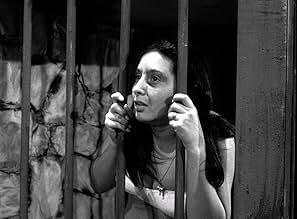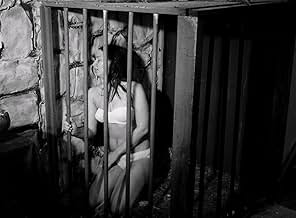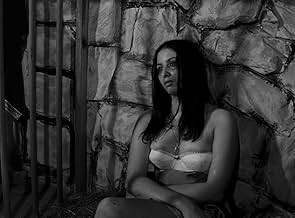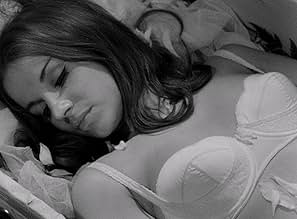le conta três episódios: um fabricante de bonecas cujas bonecas são perturbadoramente humanas, uma história de necrofilia e um médico prova que o amor está morto.le conta três episódios: um fabricante de bonecas cujas bonecas são perturbadoramente humanas, uma história de necrofilia e um médico prova que o amor está morto.le conta três episódios: um fabricante de bonecas cujas bonecas são perturbadoramente humanas, uma história de necrofilia e um médico prova que o amor está morto.
- Direção
- Roteiristas
- Artistas
Luiz Sérgio Person
- (segment "O Fabricante de Bonecas")
- (as L. S. Person)
Antônio Ravagnoli
- (segment "O Fabricante de Bonecas")
- (as Antonio F. Ravagnolli)
Ademar Silva
- (segment "O Fabricante de Bonecas")
- (as Ademir Silva)
- Direção
- Roteiristas
- Elenco e equipe completos
- Produção, bilheteria e muito mais no IMDbPro
Avaliações em destaque
Coffin Joe, the cult horror character created by Brazilian writer/director José Mojica Marins, hosts a trilogy of macabre tales.
First up is The Dollmaker, which sees a group of thugs breaking into the house of an elderly doll maker to look for an alleged stash of money. Unable to find any gold, the gang take a different kind of prize, raping the doll-maker's four beautiful daughters. The table are turned on the brutes, however, when the old man pulls a gun on the them, and the girls proceed to pluck out the mens' eyes for use in their new dolls. The plot for this one isn't anything special, with a predictable denouement, but it offers plenty of gratuitous T&A and the gory sight of the thugs' decapitated heads sans eyeballs.
The second story is Obsession, which seriously ups the weirdness ante. A balloon seller becomes obsessed with a beautiful woman, stalking her from a distance, carrying with him the box of new shoes dropped by woman during a shopping trip. On the woman's wedding day, she is stabbed and killed by a love rival. The balloon seller follows the woman's funeral procession to a crypt, which he breaks into after dark in order to fulfil his desires and return the lost shoes. A strangely lyrical tale told entirely without dialogue, Obsession tends to plod for much of its run-time, but ends in a satisfyingly twisted manner, the balloon seller breaking open the dead woman's coffin and stripping her corpse for a spot of necrophilia.
The last episode opens with the broadcast of a television debate show in which Professor Oaxiac Odez (Marins) expounds his theory that love doesn't exist. After the show, the professor invites a fellow panel member and his wife to his home, where he proceeds to shock and torture the couple in order to prove his ideology. As with his earlier Coffin Joe films, this one sees Marins' character waffling on incessantly about his lunatic philosophies, but also features plenty of exploitative content, including a man being spoon-fed molten metal, needles being pushed through flesh (for real), a sadistic acid attack, the wife drinking her husband's blood (fresh from the jugular) to quench her thirst, and a couple of gory scenes of cannibalism.
Probably not the kind of thing to appeal to casual horror fans, but those who dig weird cult world cinema should find this entertaining, especially if, like me, they also particularly enjoy the anthology format. One thing's for sure Marins' world is very strange indeed.
First up is The Dollmaker, which sees a group of thugs breaking into the house of an elderly doll maker to look for an alleged stash of money. Unable to find any gold, the gang take a different kind of prize, raping the doll-maker's four beautiful daughters. The table are turned on the brutes, however, when the old man pulls a gun on the them, and the girls proceed to pluck out the mens' eyes for use in their new dolls. The plot for this one isn't anything special, with a predictable denouement, but it offers plenty of gratuitous T&A and the gory sight of the thugs' decapitated heads sans eyeballs.
The second story is Obsession, which seriously ups the weirdness ante. A balloon seller becomes obsessed with a beautiful woman, stalking her from a distance, carrying with him the box of new shoes dropped by woman during a shopping trip. On the woman's wedding day, she is stabbed and killed by a love rival. The balloon seller follows the woman's funeral procession to a crypt, which he breaks into after dark in order to fulfil his desires and return the lost shoes. A strangely lyrical tale told entirely without dialogue, Obsession tends to plod for much of its run-time, but ends in a satisfyingly twisted manner, the balloon seller breaking open the dead woman's coffin and stripping her corpse for a spot of necrophilia.
The last episode opens with the broadcast of a television debate show in which Professor Oaxiac Odez (Marins) expounds his theory that love doesn't exist. After the show, the professor invites a fellow panel member and his wife to his home, where he proceeds to shock and torture the couple in order to prove his ideology. As with his earlier Coffin Joe films, this one sees Marins' character waffling on incessantly about his lunatic philosophies, but also features plenty of exploitative content, including a man being spoon-fed molten metal, needles being pushed through flesh (for real), a sadistic acid attack, the wife drinking her husband's blood (fresh from the jugular) to quench her thirst, and a couple of gory scenes of cannibalism.
Probably not the kind of thing to appeal to casual horror fans, but those who dig weird cult world cinema should find this entertaining, especially if, like me, they also particularly enjoy the anthology format. One thing's for sure Marins' world is very strange indeed.
I think that in the 60's you can talk about "modern" and "old" kind of horror films.The modernity of horror films was determined by the forces acting in the movie: immanent forces that eluded arcane solutions or mysterious set designing with dark, freakish and irrational characters, were forces related to a new notion of Horror. New Horror tried to find, to create, a new idea of terror closer to the "human body", an immanent and "rational" idea of terror.In this way George A. Romero's movies, with their political suggestions, are the more revolutionary in their genre and, well, i think that Marins' movies too, in their particular, experimental way, follow and reinvent the horror cinema modern notion born in 60's. In the beginning of this amazing picture Ze Do Caixao, presenting his three stories, says: "You cannot understand the terror because you are the terror!".In this statement resides the whole picture: especially the third story, the best one, shows that what scared us are the body's extremes, the "instincts" as Ze says.This argument by Marins\Do Caixao creates a modern notion of horror: filming this Marins checks new extreme forms of the bodies, a new way to be, a way that can be easily confused with sadism or with pure bizarre gory cinematographic entertainment.But Marin's way is really more radical than this kind of simple stuffs.It's an experimental way! Even if all the three stories are led by the same argument - the new notion of terror related by the new new notion of body - only the third one is successful to get the argument in a great complete visual way.Other two stories, especially the first one, are obvious and don't suggest anything new about searching a suitable image for the matter. Anyway, a good, funny too, modern and experimental horror picture. I give 9 to the third story and I give 7 1/2 to the whole picture.
Jose Mojica Marins, known as Coffin Joe in the English-speaking world, likely had no model for his style of film; there really was no Brazilian horror scene before him, and little since. This film, a series of three vignettes depicting human depravity, gore and unexpected moments of pathos, is reminiscent of Herschell Gordon Lewis, though a good deal less camp. Some of the cinematography and shot-framing is worthy of Bergman or Polanski ca. REPULSION. Done in crisp B&W, the film also has excellent music (which at times inappropriately overstates itself!), including a theme which celebrates the glory of the man Coffin Joe. This theme, like the rest of the film, may inspire chuckles, but definitely chills as well. Can't wait to see more!
I've always felt José Mojica Marins (aka Zé do Caixão, 'Coffin Joe') is somewhat of a pioneer in Brazilian cinema. Brazilian films tended, at the time, to be mere pornography (both hardcore and softcore), while now it tends to be too much 'engaged on social causes' rather than in the 'good entertainment' aspect of cinema (Brazilian romantic comedies are not GOOD entertainment).
'Strange World of Coffin Joe', as well as most of JMM's filmography, are an exception to those (which might be why he is often marginalized within Brazilian cinema): they are merely fun, eerie horror films entailing bizarre and creepy tales.
In here, we don't have Zé do Caixão appearing in character (unless you count the narration at the beginning). 'Strange World' is an anthology film, with three separate stories:
'O Fabricante de Bonecas' ('The Dollmaker') is about an old man, renowned for making dolls with impressively realistic eyes, and a group of burglars who try to steal his money and have their way with his beautiful daughters. It is an eerie and atmospheric horror tale, with a very predictable but fitting twist ending and full of eroticism that makes it a 'pleasant' watch.
'Tara' ('Fetish') is something that could easily pass off as an European drama: a tale of necrophilia about a man with a foot fetish who goes to a morgue after the now-dead woman he often fantasized about. It is pure depravity that is not far from a Pasolini film; to complete its 'artistic' aesthetic, it has no dialogue. The camera-work is good, but unless you want to see plot less perversion it should be avoidable.
'Ideologia' ('Ideology') is the only story JMM appears in (not as Zé, though). He plays a professor who, trying to prove that 'love' doesn't exist, imprisons a rival (who publicly argued this matter with him) and his wife and tortures them both to see how far their 'love' can endure in life-or-death situations. It has as much perversion as 'Tara', but not a meaningless one at that; the discussion is actually a very good one (done in JMM's trademark rhetoric of 'instinct vs reason') and the conclusion is good.
Overall, 2 out of the 3 stories are not only watchable but very fun and eerie tales. 'The Dollmaker' is the best horror-wise, but 'Ideology' manages to be one of the few 'torture porns' not to be mindless. The title song is also great if you understand what it's about.
For those not used to José Mojica Marins horror tales, though, his 'Coffin Joe' films are a better place to start with his filmography.
'Strange World of Coffin Joe', as well as most of JMM's filmography, are an exception to those (which might be why he is often marginalized within Brazilian cinema): they are merely fun, eerie horror films entailing bizarre and creepy tales.
In here, we don't have Zé do Caixão appearing in character (unless you count the narration at the beginning). 'Strange World' is an anthology film, with three separate stories:
'O Fabricante de Bonecas' ('The Dollmaker') is about an old man, renowned for making dolls with impressively realistic eyes, and a group of burglars who try to steal his money and have their way with his beautiful daughters. It is an eerie and atmospheric horror tale, with a very predictable but fitting twist ending and full of eroticism that makes it a 'pleasant' watch.
'Tara' ('Fetish') is something that could easily pass off as an European drama: a tale of necrophilia about a man with a foot fetish who goes to a morgue after the now-dead woman he often fantasized about. It is pure depravity that is not far from a Pasolini film; to complete its 'artistic' aesthetic, it has no dialogue. The camera-work is good, but unless you want to see plot less perversion it should be avoidable.
'Ideologia' ('Ideology') is the only story JMM appears in (not as Zé, though). He plays a professor who, trying to prove that 'love' doesn't exist, imprisons a rival (who publicly argued this matter with him) and his wife and tortures them both to see how far their 'love' can endure in life-or-death situations. It has as much perversion as 'Tara', but not a meaningless one at that; the discussion is actually a very good one (done in JMM's trademark rhetoric of 'instinct vs reason') and the conclusion is good.
Overall, 2 out of the 3 stories are not only watchable but very fun and eerie tales. 'The Dollmaker' is the best horror-wise, but 'Ideology' manages to be one of the few 'torture porns' not to be mindless. The title song is also great if you understand what it's about.
For those not used to José Mojica Marins horror tales, though, his 'Coffin Joe' films are a better place to start with his filmography.
The third "Zé do Caixão"/"Coffin Joe" film by José Mojica Marins, the man who personifies Brazilian Horror cinema (mainly as his alter ego Coffin Joe) is the greatest of the bunch, even though it does not include a story about the eponymous demented gravedigger in eternal search of a woman to bear him an heir. "O Estrano Mundo de Zé do Caixão" aka. "The Strange world of Coffin Joe" (1968) is not really a Coffin Joe film as such, but Marins' delightfully demented take on the popular art-form of Horror anthologies. After a typically weird introduction by the director/writer/star's alter ego Coffin Joe, "O Estrano Mundo de Zé do Caixão" tells three macabre tales, all delightfully demented, perverted and grotesque. It is amazing that a black and white third-world production with an obviously low budget could turn out to actually be one of the most explicit and deranged pre-1970 exploitation productions ever. The three tales in "O Estrano Mundo de Zé do Caixão" include delicate subjects such as rape, cannibalism, desecration of corpses and necrophilia, and their depiction is very explicit for the time to say the least.
After a tale about a shy pervert who is willing to follow the lady of his dreams anywhere, and one about the sinister secret of a doll maker and his nymphomaniac daughters, the film culminates in a story in which José Mojica Marins himself plays another truly morbid role of a demented scientist. I do not wish to go into detail about the three stories presented in "The Strange World of Coffin Joe", but I can assure that they are entirely macabre and demented enough for this film to be a must-see for every lover of Cult Horror and Exploitation cinema. The film has its cheesy moments, of course, and the acting obviously isn't the best, but these things only contribute to the incredible camp charm of the movie. As mentioned before, the topics are incredibly macabre, morbid and perverted their depictions include some very explicit gore (severed limbs, etc.) for the time, as well as quite a bit of female nudity. The latter is of course also very welcome, especially since the female cast consists entirely of ravishing Brazilian beauties.
"O Estrano Mundo de Zé do Caixão" is a film that can be admired for many a reason, but that must be seen for two in particular. One reason is that this is one of the most explicit and deranged 60s exploitation flicks ever. The other is that there is hardly another film that shows such love for the Horror-genre, and such passion behind making a low-budget production (from everybody involved) as does "The Strange World of Coffin Joe". No fellow fan of cult-cinema should consider missing it. José Mojica Marins, we worship thee.
After a tale about a shy pervert who is willing to follow the lady of his dreams anywhere, and one about the sinister secret of a doll maker and his nymphomaniac daughters, the film culminates in a story in which José Mojica Marins himself plays another truly morbid role of a demented scientist. I do not wish to go into detail about the three stories presented in "The Strange World of Coffin Joe", but I can assure that they are entirely macabre and demented enough for this film to be a must-see for every lover of Cult Horror and Exploitation cinema. The film has its cheesy moments, of course, and the acting obviously isn't the best, but these things only contribute to the incredible camp charm of the movie. As mentioned before, the topics are incredibly macabre, morbid and perverted their depictions include some very explicit gore (severed limbs, etc.) for the time, as well as quite a bit of female nudity. The latter is of course also very welcome, especially since the female cast consists entirely of ravishing Brazilian beauties.
"O Estrano Mundo de Zé do Caixão" is a film that can be admired for many a reason, but that must be seen for two in particular. One reason is that this is one of the most explicit and deranged 60s exploitation flicks ever. The other is that there is hardly another film that shows such love for the Horror-genre, and such passion behind making a low-budget production (from everybody involved) as does "The Strange World of Coffin Joe". No fellow fan of cult-cinema should consider missing it. José Mojica Marins, we worship thee.
Você sabia?
- CuriosidadesA 2023 reissue of this film and others in the Coffin Joe series was released by Arrow Video with artwork by Brazilian artist Butcher Billy.
- Citações
Zé do Caixão (Introduction): You can't accept the terror because you are the terror!
- Versões alternativasThe DVD version has a 3 minute color introduction, to a running time of 83 minutes.
- ConexõesEdited from O Estranho Mundo de Zé do Caixão (1968)
- Trilhas sonorasZé do Caixão
(musical theme)
Written by José Mojica Marins
Played by Titulares do Ritmo, and
Sung by Edson Lopes
Principais escolhas
Faça login para avaliar e ver a lista de recomendações personalizadas
- How long is The Strange World of Coffin Joe?Fornecido pela Alexa
Detalhes
- Data de lançamento
- País de origem
- Idioma
- Também conhecido como
- The Strange World of Coffin Joe
- Locações de filme
- Calçados Dima, São Paulo, São Paulo, Brasil(buying spree, in the segment "Tara")
- Empresa de produção
- Consulte mais créditos da empresa na IMDbPro
- Tempo de duração
- 1 h 20 min(80 min)
- Cor
- Mixagem de som
- Proporção
- 1.37 : 1
Contribua para esta página
Sugerir uma alteração ou adicionar conteúdo ausente




















